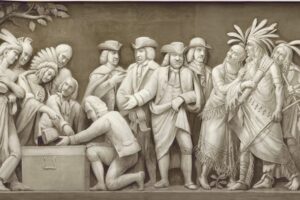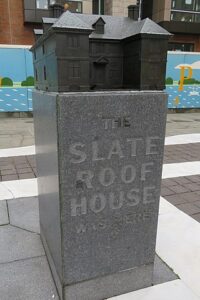
Aerial view of William Penn statue atop Philadelphia City Hall, 28 July 2019, photo Toniklemm, CCA-SA 4.0 Int’l.
The William Penn statue that has looked down from Philadelphia City Hall for over a century may be a cultural icon, but that didn’t stop unnamed bureaucrats at the National Park Service (NPS) from planning to remove the statue’s “little brother” from a nearby park in the name of “inclusivity.” After a firestorm of criticism, the NPS backed down, stating that the statue would remain, now with additional “context” about Penn’s interactions with Native Americans. Such efforts to “contextualize” historic statues are a positive step away from a spate of iconoclasm brought on in the aftermath of the George Floyd protests.
The William Penn statue at the heart of the controversy is a copy of the City Hall original. It was erected in 1982 as the focal point of “Welcome Park” named after the ship that bore Penn and a contingent of Quaker refugees to America. The Park is located near Independence Hall on federal land under NPS control. The site is directly linked both to Penn and Native Americans. Penn’s home once stood on the site. After Penn died, his grandson deeded the land to the Six Nations from the Iroquois Confederacy (also called Haudenosaunee) as a meeting place for tribal members visiting Penn’s city. Ultimately, however, Native Americans were forced from the area with the remaining members of the Haudenosaunee now residing in Oklahoma.

Haudenosaunee and William Penn signing treaty, artist Constantino Brumidi, fresco worked in grisaille, located in U.S. Capitol Building.
In 2020, some tribal members visited Welcome Park, afterwards expressing disappointment that there was no mention whatsoever about the importance of the land to their own history. This event evidently set in motion the NPS decision to completely revamp the park in time for the 250th anniversary of the Declaration of Independence in 2026. According to the NPS, the effort that resulted in the decision to erase all evidence of Penn by removing both his statue and a small model of Penn’s home arose from consultations with the Tribes, a claim the Tribes themselves later denied. After all, Penn was one of the “good guys” who resisted efforts to drive Native Americans from the land. Indeed, a fresco in the U.S. Capitol Rotunda commemorates Penn’s Treaty of Shackamaxon. That treaty formalized Quaker land purchases in Pennsylvania and helped ensure an amicable relationship between Native Americans and the Colonists that lasted for almost a hundred years.

Slate Roof House model, Welcome Park, Philadelphia, PA, USA. Photo by Kreuz und quer, 8 January 2019, CCA-SA 4.0 Int’l.
Whatever NPS was thinking, reaction was swift after Pennsylvanians learned that the NPS slipped in a mention that a decision had already been made to remove the statue into an otherwise routine notice seeking public comment about the park’s reconstruction. Once word got out on social media, Republican lawmakers and conservative leaning media pounced, alleging that the ‘liberal Biden Administration’ sought to ‘cancel’ Penn. Republican Pennsylvania House of Representatives leader Bryan Cutler, who is a descendant of early Quaker colonists, characterized the decision as wokeism at its worst. He issued a press release that stated, “To remove Penn’s statue to create a more inclusive environment takes [an] absurd and revisionist view of our state’s history and further seems to serve no purpose other than to check a box for an increasingly dangerous radicalism infiltrating today’s left wing political agenda.”
The firestorm prompted Pennsylvania Democratic Governor Josh Shapiro to intervene personally. The Governor soon announced on social media that “his team” had been “in contact with the Biden Administration throughout to correct the decision” and “I’m pleased Welcome Park will remain the rightful home of this William Penn statue — right here in the Commonwealth of Pennsylvania Penn founded.”
A chagrined NPS claimed it was all a misunderstanding. According to a NPS press release, “Independence National Historical Park has withdrawn the review of a draft proposal to rehabilitate Welcome Park and closed the public comment period. The preliminary draft proposal, which was released prematurely and had not been subject to a complete internal agency review, is being retracted. No changes to the William Penn statue are planned.”

Woman and man visiting Socialist dictatorial figures and art at Memento Statue Park, Budapest, Hungary.
This is all for the good. Iconoclastic efforts to destroy historic statues by mob violence or remove them by legal means are too often based on a binary view of history which often says more about today’s political climate than the individuals commemorated on the statues themselves. What began as an effort to remove statues of Confederate leaders has expanded to include Christopher Columbus, U.S. Presidents Lincoln and Grant, and even Catholic Saints.
Efforts to provide more historic context to these statues is often a better option. Indeed, in this particular case, representatives of Native American tribes have emphasized that they never sought the removal of William Penn’s statue, only that their own story be told in the newly reimagined “Welcome Park.”
Other countries have grappled with this issue as well, finding their own way to preserve historic statutes while using their imagery to tell new stories, sometimes with humor. For example, in the early 1990’s the former east bloc country of Hungary moved statues of Communist luminaries to their own theme park, complete with a Socialist era soundtrack.
Next Installment: Grading Services, Good for Collecting or Not?
Further Reading:
On Penn Controversy
Phaedra Trethan, Native tribes don’t want statue of William Penn removed. They want their story told, USA Today (January 27, 2024).
Sarah Kuta, Officials Reverse Plans to Remove William Penn Statue From a Philadelphia Park, Smithsonian Magazine Smart News (January 11, 2024).
Park withdraws review of Welcome Park rehabilitation proposal, National Park Service News Release (January 8, 2024).
Jonathan Turley, Celebrating Sylvania: NPS Moves to Remove Statute of Penn, Jonathan Turley, Res Ipsa Loquitur-The Thing Itself Speaks (January 8, 2023).
Billy Penn Staff, UPDATE: William Penn statue to stay at Philly’s Welcome Park after criticism, BillyPenn at WHYY (January 8, 2024).
Cutler decries Biden administration attempt to cancel William Penn, Republican Leader Bryan Cutler (January 8, 2024).
On the William Penn Fresco in the Capitol Building
William Penn and the Indians, Architect of the Capitol.
On Other “Contextualization”
Charlotte Rene Woods, ‘Stonewall’ Jackson statue is heading to California to become the centerpiece of a historically contextualizing art exhibit, Charlottesville Tomorrow (December 20, 2021).
Jennifer Walker, Budapest’s Memento Park: Where communist statues are laid to rest, CNN (June 7, 2018).
[1] Peter K. Tompa is a semi-retired lawyer who resides in Washington, D.C. He has written extensively about cultural heritage issues, particularly those of interest to the numismatic trade. Peter contributed to Who Owns the Past?” (K. Fitz Gibbon, ed. Rutgers 2005). He formerly served as executive director of the Global Heritage Alliance and now is a member of its board of directors. (https://global-heritage.org/) This article is a public resource for general information and opinion about cultural property issues and is not intended to be a source for legal advice. Any factual patterns discussed may or may not be inspired by real people and events.
 Statue of William Penn, Welcome Park - site of William Penn's House in 1699, photo Reading Tom, UK, CCA 2.0 Generic license.
Statue of William Penn, Welcome Park - site of William Penn's House in 1699, photo Reading Tom, UK, CCA 2.0 Generic license. 

